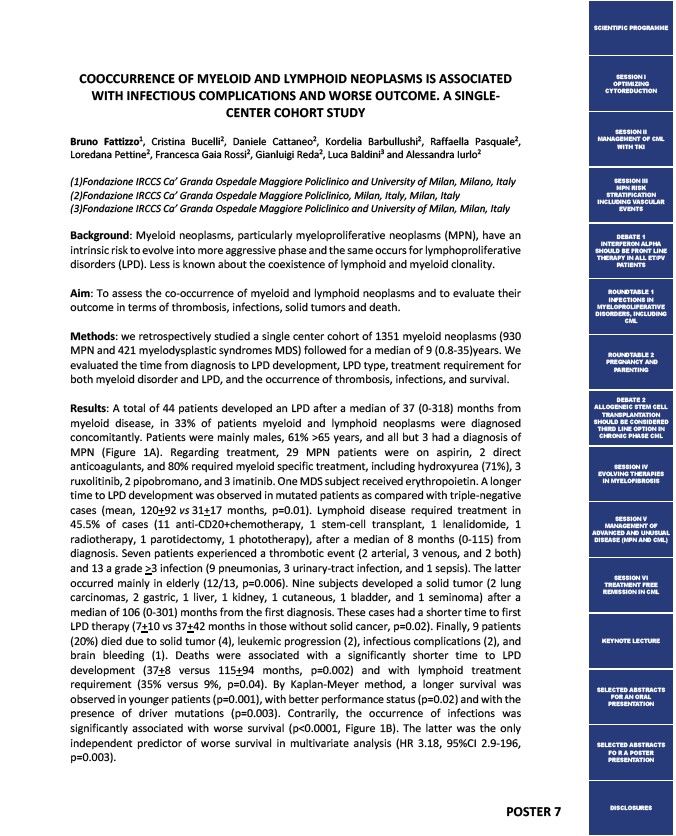
COOCCURRENCE OF MYELOID AND LYMPHOID NEOPLASMS IS ASSOCIATED
WITH INFECTIOUS COMPLICATIONS AND WORSE OUTCOME. A SINGLE-CENTER
POSTER 7
COHORT STUDY
Bruno Fattizzo1, Cristina Bucelli2, Daniele Cattaneo2, Kordelia Barbullushi2, Raffaella Pasquale2,
Loredana Pettine2, Francesca Gaia Rossi2, Gianluigi Reda2, Luca Baldini3 and Alessandra Iurlo2
(1)Fondazione IRCCS Ca’ Granda Ospedale Maggiore Policlinico and University of Milan, Milano, Italy
(2)Fondazione IRCCS Ca’ Granda Ospedale Maggiore Policlinico, Milan, Italy, Milan, Italy
(3)Fondazione IRCCS Ca’ Granda Ospedale Maggiore Policlinico and University of Milan, Milan, Italy
Background: Myeloid neoplasms, particularly myeloproliferative neoplasms (MPN), have an
intrinsic risk to evolve into more aggressive phase and the same occurs for lymphoproliferative
disorders (LPD). Less is known about the coexistence of lymphoid and myeloid clonality.
Aim: To assess the co-occurrence of myeloid and lymphoid neoplasms and to evaluate their
outcome in terms of thrombosis, infections, solid tumors and death.
Methods: we retrospectively studied a single center cohort of 1351 myeloid neoplasms (930
MPN and 421 myelodysplastic syndromes MDS) followed for a median of 9 (0.8-35)years. We
evaluated the time from diagnosis to LPD development, LPD type, treatment requirement for
both myeloid disorder and LPD, and the occurrence of thrombosis, infections, and survival.
Results: A total of 44 patients developed an LPD after a median of 37 (0-318) months from
myeloid disease, in 33% of patients myeloid and lymphoid neoplasms were diagnosed
concomitantly. Patients were mainly males, 61% >65 years, and all but 3 had a diagnosis of
MPN (Figure 1A). Regarding treatment, 29 MPN patients were on aspirin, 2 direct
anticoagulants, and 80% required myeloid specific treatment, including hydroxyurea (71%), 3
ruxolitinib, 2 pipobromano, and 3 imatinib. One MDS subject received erythropoietin. A longer
time to LPD development was observed in mutated patients as compared with triple-negative
cases (mean, 120+92 vs 31+17 months, p=0.01). Lymphoid disease required treatment in
45.5% of cases (11 anti-CD20+chemotherapy, 1 stem-cell transplant, 1 lenalidomide, 1
radiotherapy, 1 parotidectomy, 1 phototherapy), after a median of 8 months (0-115) from
diagnosis. Seven patients experienced a thrombotic event (2 arterial, 3 venous, and 2 both)
and 13 a grade >3 infection (9 pneumonias, 3 urinary-tract infection, and 1 sepsis). The latter
occurred mainly in elderly (12/13, p=0.006). Nine subjects developed a solid tumor (2 lung
carcinomas, 2 gastric, 1 liver, 1 kidney, 1 cutaneous, 1 bladder, and 1 seminoma) after a
median of 106 (0-301) months from the first diagnosis. These cases had a shorter time to first
LPD therapy (7+10 vs 37+42 months in those without solid cancer, p=0.02). Finally, 9 patients
(20%) died due to solid tumor (4), leukemic progression (2), infectious complications (2), and
brain bleeding (1). Deaths were associated with a significantly shorter time to LPD
development (37+8 versus 115+94 months, p=0.002) and with lymphoid treatment
requirement (35% versus 9%, p=0.04). By Kaplan-Meyer method, a longer survival was
observed in younger patients (p=0.001), with better performance status (p=0.02) and with the
presence of driver mutations (p=0.003). Contrarily, the occurrence of infections was
significantly associated with worse survival (p<0.0001, Figure 1B). The latter was the only
independent predictor of worse survival in multivariate analysis (HR 3.18, 95%CI 2.9-196,
p=0.003).
SCIENTIFIC PROGRAMME
SESSION I
OPTIMIZING
CYTOREDUCTION
SESSION II
MANAGEMENT OF CML
WITH TKI
SESSION III
MPN RISK
STRATIFICATION
INCLUDING VASCULAR
EVENTS
DEBATE 1
INTERFERON ALPHA
SHOULD BE FRONT LINE
THERAPY IN ALL ET/PV
PATIENTS
ROUNDTABLE 1
INFECTIONS IN
MYELOPROLIFERATIVE
DISORDERS, INCLUDING
CML
ROUNDTABLE 2
PREGNANCY AND
PARENTING
DEBATE 2
ALLOGENEIC STEM CELL
TRANSPLANTATION
SHOULD BE CONSIDERED
THIRD LINE OPTION IN
CHRONIC PHASE CML
SESSION IV
EVOLVING THERAPIES
IN MYELOFIBROSIS
SESSION V
MANAGEMENT OF
ADVANCED AND UNUSUAL
DISEASE (MPN AND CML)
SESSION VI
TREATMENT FREE
REMISSION IN CML
KEYNOTE LECTURE
SELECTED ABSTRACTS
FOR AN ORAL
PRESENTATION
SELECTED ABSTRACTS
FO R A POSTER
PRESENTATION
DISCLOSURES